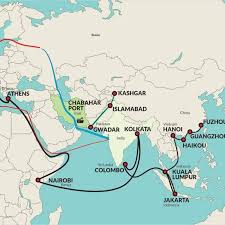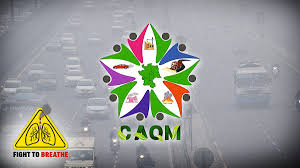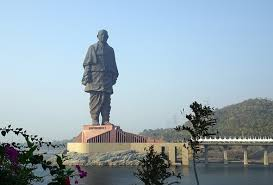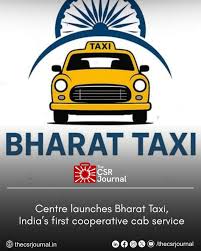Prelims
Chabahar Port

Context: India received six-month US sanctions waiver for Iran’s Chabahar Port, enabling essential supplies to Afghanistan through the strategic facility.
Chabahar Port
- It is a deep-water port located in Iran’s Sistan-Baluchistan province on Gulf of Oman, situated at mouth of Strait of Hormuz
- It is only Iranian port with direct access to Indian Ocean.
- Consists of two separate ports: Shahid Beheshti and Shahid Kalantari terminals for operations.
- Strategic Importance
- Geographic proximity to Afghanistan, Pakistan, India makes it potential regional commercial hub significantly.
- Key transit center on International North-South Transport Corridor (INSTC) connecting Indian Ocean to Europe.
- INSTC: multi-modal route linking Indian Ocean, Persian Gulf to Caspian Sea via Iran to northern Europe.
- Kandla port (Gujarat): 550 Nautical Miles and Mumbai: 786 Nautical Miles distance from Chabahar.
- Chabahar Project
- May 2016: India signed tripartite agreement with Iran and Afghanistan to develop Shahid Beheshti Terminal.
- India’s first foreign port project marking significant milestone in international infrastructure development efforts.
- Agreement aims to establish international transport and transit corridor in Chabahar for regional connectivity.
- Major highlights: construction of Chabahar Port and rail line from Chabahar to Zahedan enhancing connectivity.
- Objectives
- Enable India to bypass Pakistan and access Afghanistan, ultimately reaching Central Asia strategically.
- Serve as hub for transit trade between India, Iran, Afghanistan providing alternative route.
- Offers alternative to traditional Silk Road passing through China reducing dependency on Chinese routes.
Commission for Air Quality Management (CAQM)

About CAQM
- Statutory body established under Commission for Air Quality Management in NCR and Adjoining Areas Act, 2021.
- Mandate: better coordination, research, identification, resolution of problems surrounding air quality index management.
- Undertakes prevention and control of air pollution in Delhi-NCR & Adjoining Areas impacting National Capital Territory.
- Coordinates with Delhi and adjoining states: Punjab, Haryana, Rajasthan, Uttar Pradesh for air quality monitoring.
- Powers
- Restrict activities influencing air quality to prevent pollution and environmental degradation measures.
- Investigate, conduct research on environmental pollution impacting air quality; prepare codes/guidelines for prevention.
- Issue binding directions on inspections, regulations; concerned person/authority must comply with directions mandatorily.
- All directions and orders binding: any person, officer, authority bound to comply ensuring enforcement.
- Directly accountable to Parliament ensuring transparency and legislative oversight of commission’s functioning.
- Composition
- Chairperson: government official rank of Secretary or Chief Secretary; tenure three years or until age 70.
- Members
- Five ex officio members: Chief Secretaries/Secretaries in charge of environment protection departments in Delhi, Punjab, Haryana, Rajasthan, UP.
- Three full-time technical members providing specialized expertise for air quality management decisions.
- Three members from non-government organizations ensuring civil society participation in commission’s work.
- Technical members from: Central Pollution Control Board (CPCB), Indian Space Research Organisation (ISRO), NITI Aayog.
Project Cheetah

About the project
- Launched in 2022 to reintroduce cheetahs, extinct in India for over 70 years.
- World’s first intercontinental large wild carnivore translocation project under Project Tiger implementation.
- Implements Cheetah Action Plan for systematic reintroduction and conservation of cheetahs in India.
Objectives
- Establish breeding populations of cheetahs in safe habitats across historical range in India.
- Use cheetahs as flagship species to restore open forests and savanna ecosystems ecologically.
- Promote eco-development and ecotourism to improve local livelihoods and community participation.
- Enhance community awareness and reduce human-wildlife conflict through education and engagement initiatives.
Implementation and Governance
- National Tiger Conservation Authority (NTCA) under Ministry of Environment, Forests and Climate Change implements project.
- Collaboration with Madhya Pradesh Forest Department and Wildlife Institute of India (WII) for execution.
- Cheetah Project Steering Committee established in 2023 by NTCA to supervise, evaluate, advise implementation.
Achievements
- 8 cheetahs from Namibia, 12 from South Africa relocated to Kuno National Park exhibiting natural behaviors.
- Birth of Namibian cheetah cubs in India after 75 years significant milestone in reintroduction effort.
- Over 350 ‘Cheetah Mitras’ involved to educate locals and mitigate human-wildlife conflict effectively.
Sardar Vallabhbhai Patel – Iron Man Of India

- Early Life & Education
- Born October 31, 1875, in Nadiad, Gujarat, to Jhaverbhai and Ladba Patel.
- Followed Vaishnavism tradition with Pushtimarg sect Diksha.
- At age 36, traveled to England, completed law from Middle Temple, and became successful barrister in Ahmedabad.
- Political Journey & Freedom Struggle
- Early Career: Inspired by Gandhi, served as Sanitation Commissioner (1917) and Chairman of Ahmedabad Municipal Committee (1924-1928), introducing urban planning and sanitation reforms.
- Became Gujarat Sabha Secretary (1917) and INC President (1931, Karachi session), where Congress passed Fundamental Rights resolution and ratified Gandhi-Irwin Pact.
- Key Movements:
- Kheda Satyagraha (1918): Fought for land revenue exemption due to crop failure; achieved relief after three-month campaign
- Non-Cooperation Movement (1920): Abandoned law practice, toured villages, organized anti-British protests and foreign goods boycott
- Bardoli Satyagraha (1928): Led farmers’ struggle against unjust revenue increase; earned title “Sardar” after successful resolution
- Quit India Movement (1942): Supported AICC resolution; arrested and detained at Ahmednagar Fort
- Post-Independence Contributions
- Deputy Prime Minister handling Home Affairs, States, Information & Broadcasting ministries.
- Political Integration: Unified 560+ princely states into Indian Union through diplomacy and decisive action (Hyderabad, Junagadh).
- Prevented Balkanization, earning title “Iron Man of India”.
- Administrative Legacy: Established All India Services as the “Steel Frame” for unified governance, earning title “Father of All India Services”.
- Legacy:
- He died on December 15, 1950.
- The Statue of Unity (2018) commemorates his nation-building vision and stands as the world’s tallest statue in Gujarat.
- He is remembered for prioritising national integrity and unity above all, and his pragmatic approach to consolidating India’s diverse regions into a cohesive nation.
Why Is Fentanyl So Dangerous?

About Fentanyl
- Potent synthetic opioid like morphine or heroin (both prescribed drug and illegally used substance).
- Made entirely in laboratories with no natural ingredients thus it is a fully synthetic pharmaceutical compound production.
- Developed as prescription medicine for treating severe pain such as post-surgery or cancer pain.
- Effective for severe chronic pain not responding to other medicines.
Potency and Action
- Approximately 100 times more potent than morphine and 50 times more potent than heroin as analgesic.
- Acts in central nervous system (CNS) or brain to relieve pain effectively through receptor binding.
- Side effects include drowsiness, dizziness caused by CNS actions requiring medical supervision always.
Addiction and Risks
- Fentanyl is addictive; repeated use causes brain activity to change, continuing use despite harmful effects.
- Cheap for drug dealers to make compared to other opioids but more powerful making production profitable.
- Few grains enough to kill; causing high rates of overdose and overdose deaths globally.
About Opioids
- Opioids include compounds extracted from poppy plant (Papaver somniferum), semisynthetic, synthetic compounds interacting with brain receptors.
- Commonly used for pain treatment: morphine, fentanyl, tramadol medicines prescribed medically under supervision.
- Non-medical use, prolonged use, misuse can lead to opioid dependence and health problems requiring intervention.
- Cause breathing difficulties; opioid overdose can lead to death through respiratory system failure critically.
- Other opioids include oxycodone, morphine, codeine, heroin with varying potency and addiction potential.
Bharat Taxi – India’s First Cooperative Cab Service

About Bharat Taxi
- India’s first cooperative cab service launching November 2025 in Delhi.
- Government-backed cooperative ride-hailing platform empowering cab drivers as members and shareholders ensuring collective ownership.
- Departure from corporate aggregator model ensuring transparency and equitable income distribution for drivers.
- Implementation
- Implemented by Union Ministry of Cooperation with National e-Governance Division (NeGD) collaboration for execution.
- Objectives
- Establish fair, transparent, sustainable cab ecosystem ensuring driver welfare eliminating exploitative commissions comprehensively.
- Provide affordable rides for passengers; integrate with India’s digital governance ecosystem seamlessly nationwide.
- Key Features
- Cooperative Model: managed by Sahakar Taxi Cooperative Ltd.; initial capital ₹300 crore backed by cooperatives.
- Backed by Amul, IFFCO, NAFED, KRIBHCO, NABARD, NCDC ensuring institutional support and credibility.
- Driver Ownership: drivers called “Saarthis” are shareholders, not contract workers; retain 100% fare earnings.
- Digital Integration: linked with DigiLocker, UMANG, API Setu for secure identity verification and service access.
- No surge pricing or hidden costs; fares regulated and transparent ensuring affordability for commuters.
- Phased Rollout: 650 driver-owners in Delhi (Nov 2025); 20 cities by 2026; 1 lakh cabs by 2030.
Significance
- Promotes cooperative entrepreneurship model in India’s digital economy fostering inclusive growth and ownership.
- Ensures income security and dignity for drivers addressing urban mobility challenges sustainably and equitably.
- Reduces dependence on private aggregators encouraging fair competition and local ownership in transport sector.
KOYLA SHAKTI Dashboard and CLAMP Portal

KOYLA SHAKTI Dashboard
- Smart Coal Analytics Dashboard (SCAD) developed by Ministry of Coal as unified digital platform.
- Integrates entire coal value chain from mine to market enabling comprehensive monitoring and management.
- Objectives
- Act as digital backbone of India’s coal ecosystem enabling real-time monitoring, data integration nationwide.
- Enable evidence-based policy formulation for improved operational efficiency through analytics and insights.
- Key Features
- Unified visibility: integrates data from coal production, logistics, consumption into single interface comprehensively.
- Real-time monitoring: tracks coal movement through rail, road, multimodal systems with live analytics.
- Data-driven governance: enables predictive analytics for demand forecasting and resource allocation optimization.
- Incident response system: provides alerts for operational disruptions supporting rapid redressal and resolution.
- Transparency and accountability: displays KPIs for all stakeholders ensuring open and fair monitoring.
CLAMP Portal
- Coal Land Acquisition, Management, and Payment Portal centralized digital solution for land management.
- Manages land acquisition, compensation, R&R processes in coal-bearing areas digitally and efficiently.
- Objectives
- Ensure time-bound, transparent, equitable land management digitizing records, payments, inter-agency coordination comprehensively.
- Key Features
- End-to-end digital workflow: from uploading land records to final compensation payment streamlining processes.
- Central repository: maintains updated land ownership and compensation details for transparency and accessibility.
- Reduces human discretion and procedural delays ensuring transparency and accountability in land management.
- Integration across PSUs: links coal PSUs, State departments, district authorities for coordinated implementation.
- Citizen-centric governance: ensures fair, prompt rehabilitation and resettlement for affected communities.
Indi and Puliyankudi Limes

Context
- APEDA facilitated first-ever air shipment of GI-tagged Indi Lime (Karnataka), Puliyankudi Lime (Tamil Nadu) to UK.
About GI Tag
- Geographical Indication (GI): Intellectual Property Right identifying goods from specific geographical region with linked quality.
- Registered under GI of Goods (Registration and Protection) Act, 1999 for legal protection.
- Issued by: Geographical Indication Registry, Chennai under DPIIT, Ministry of Commerce and Industry.
- Aim: protect regional products, promote authenticity, enhance market value, ensure economic benefits for local producers.
Indi Lime (Karnataka)
- Region: cultivated mainly in Vijayapura district, Karnataka with distinctive characteristics recognized nationally.
- Distinct features: known for high juice yield, zesty aroma, balanced acidity preferred in culinary uses.
- Valued in culinary, traditional medicine, cultural practices reflecting Karnataka’s deep-rooted agrarian heritage.
Puliyankudi Lime (Tamil Nadu)
- Region: grown extensively in Tenkasi district, known as “Lemon City of Tamil Nadu” nationally.
- Variety: especially Kadayam Lime, prized for thin peel, strong acidity, high juice content (≈55%).
- Nutritional value: contains 34.3 mg/100g ascorbic acid rich in Vitamin C and antioxidants aiding immunity.
- GI tag received April 2025 acknowledging regional uniqueness and superior quality of Tamil Nadu limes.

